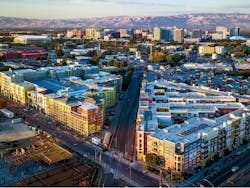Another City — San Jose, California — Goes All Electric in a Growing Trend
In an effort to decarbonize, San Jose on Tuesday became the largest California city to embrace all electric buildings.
The city council approved measures to boost efficiency in new non-residential buildings with gas infrastructure, beginning January 2020, and to ensure new buildings are electric vehicle (EV) ready.
In addition, the city council will return in October and develop an ordinance implementing a ban on natural gas infrastructure in homes and multifamily low rise buildings, beginning January 2020, said Panama Bartholomy, director of the Building Decarbonization Coalition, which works with building industry stakeholders, energy providers, environmental organizations and local governments to decarbonize buildings. The efficiency requirements are so rigorous it’s likely they’ll deter building owners from using natural gas, he said.
Drone photo of downtown San Jose. By Uladzik Kryhin/Shutterstock.com
“They have to basically be 10 to 15% or more efficient in 2020. The city is saying, ‘Build electric or extremely efficient.’ The cost of using gas will be pretty prohibitive.”
To boost EV adoption, the city council approved measures calling for new multi-family buildings to include 70% of EV capable spaces, at least 20% of EV ready spaces and at least 10% of full EV service equipment spaces by 2020, said Kimi Narita, director of Buildings and Energy, American Cities Climate Challenge, National Resources Defense Council.
The energy efficiency and EV requirements will become part of the city’s newest building code, effective in 2020 and are part of the “Building Reach Code” for new residential and commercial construction. That code goes beyond standard codes, calling for decarbonization measures.
San Jose joins more than 50 California cities mulling similar measures, said Bartholomy.
“We think by the end of the year, 40% of Californians will live in a city that has adopted electrification by certain target dates,” he said.
San Jose is 8th all electric California city
San Jose is the eighth California city to pass measures to prioritize electricity.
In July, Berkeley became the nation’s first city to prohibit natural gas from new construction, and cities including Menlo Park, San Luis Obispo, Santa Monica, San Mateo, Windsor and Carlsbad have all passed codes incentivizing or requiring all electric new construction recently.
The Building Decarbonization Coalition has created a roadmap to decarbonize California’s buildings, saying residential buildings produce about two-thirds of the state’s building emissions, and commercial buildings produce around one-third. The roadmap is a plan for the state to cut building emissions 20% in the next six years and 40% by 2030.
In a memorandum about the meeting, the city said, “The effects of climate change are devastating and increasing.” Earlier, to help reduce greenhouse gas emissions, the city adopted a plan called “Climate Smart San Jose,” which sets aggressive goals for the adoption of EVs, solar and net zero energy/carbon buildings.
“The proposed reach code is designed to lower and eventually eliminate greenhouse gas emissions from new construction,” said the memo.
Quicker & less expensive
Studies show that moving to electricity-powered appliances in new construction will allow developers to build more quickly and less expensively and save homeowners money, said Bartholomew.
“The vast majority of the time, it makes more sense with the current electric mix to use electric, not gas,” he said. “One way to think about it, from an emissions perspective, it’s about the total life cycle of gas. You have to consider the extraction process and emissions and pipe leakages.
“It’s more efficient to burn gas in high-efficiency gas power plants and then turn electricity over to heat pump water heaters,” he said.
California utilities close to 50% renewables
Half of California’s grid is supplied by natural gas. The other sources are hydroelectricity, one nuclear power plant and renewable energy. Next year, 50% of the state’s electricity from utilities will come from renewable energy.
The council is encouraging the use of heat pump water heaters, heat pump air conditioners, magnetic induction stoves and electric clothes dryers, he said.
The city was one of the first in the US to adopt a climate action plan aligned with the Paris Climate Agreement. Climate Smart San Jose was approved by the city council in February 2018.
The code will especially benefit San Jose’s low income communities, which are affected more than others by the negative environmental and financial impacts associated with natural gas in buildings and gasoline vehicles, said the memo.
“The reach code will provide many benefits including: significant GHG emissions reductions;financial benefits related to lower cost electric construction, facilitate the transition to EVs, and avoidance of significant EV charging retrofit costs; and public health benefits by reducing both indoor and outdoor air pollution,” said the city’s memo.
Track news about the growing trend toward electric trend cities. Subscribe to the free Microgrid Knowledge newsletter.
About the Author
Lisa Cohn
Contributing Editor
I focus on the West Coast and Midwest. Email me at [email protected]
I’ve been writing about energy for more than 20 years, and my stories have appeared in EnergyBiz, SNL Financial, Mother Earth News, Natural Home Magazine, Horizon Air Magazine, Oregon Business, Open Spaces, the Portland Tribune, The Oregonian, Renewable Energy World, Windpower Monthly and other publications. I’m also a former stringer for the Platts/McGraw-Hill energy publications. I began my career covering energy and environment for The Cape Cod Times, where Elisa Wood also was a reporter. I’ve received numerous writing awards from national, regional and local organizations, including Pacific Northwest Writers Association, Willamette Writers, Associated Oregon Industries, and the Voice of Youth Advocates. I first became interested in energy as a student at Wesleyan University, Middletown, Connecticut, where I helped design and build a solar house.
Twitter: @LisaECohn
Linkedin: LisaEllenCohn
Facebook: Energy Efficiency Markets

